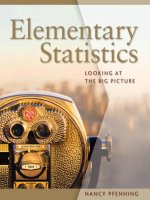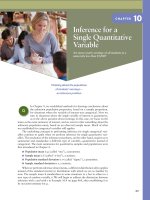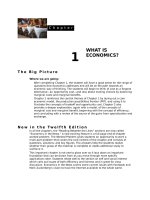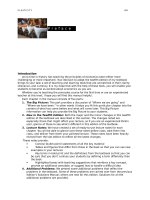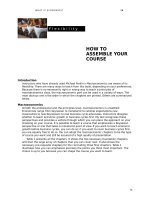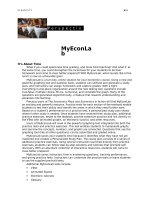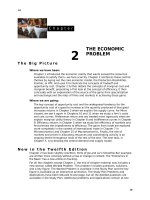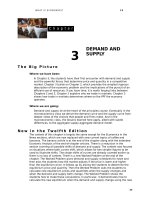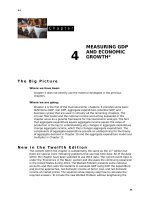The big picture marcoeconomics 12e parkin chapter 14
Bạn đang xem bản rút gọn của tài liệu. Xem và tải ngay bản đầy đủ của tài liệu tại đây (271.97 KB, 11 trang )
M O N E T A RY P O L I C Y
C h a p t e r
14
MONETARY
POLICY**
The Big Picture
Where we have been:
Chapter 14 heavily uses material from Chapter 8, which was the first chapter
dealing with money, and Chapter 10, which introduced the aggregate supplyaggregate demand model. The expenditure multiplier, covered in Chapter 11,
plays a small role in this chapter. Playing a larger role is the loanable funds
market, developed in Chapter 7.
Where we are going:
Chapter 14 is the last dealing with macroeconomics. The next chapter, on
international trade, will not use the material from this chapter.
N e w i n t h e Tw e l f t h E d i t i o n
This chapter is largely the same as the eleventh edition with a nice update to the
At Issue section along with data updates throughout. The At Issue section now
presents opposing opinions from Janet Yellen and other members of the Federal
Reserve System. The Economics In The News feature has a 2014 story and
analysis about the Fed’s continued promises to keep interest rates low in the near
future. The Worked Problem discusses federal funds rate movement and its effect
on other macroeconomic variables. It challenges the student to explain how and
when a Fed policy to stimulate the economy works. To include the new Worked
Problem without lengthening the chapter, some problems have been removed
from the Study Plan Problem and Applications. These problems are still in the
MyEconLab and are called Extra Problems.
129
Lecture Notes
Monetary Policy
The Fed can influence the federal funds interest rate and thereby affect economic
activity. What are the transmission channels of monetary policy?
What are alternative monetary policy strategies?
The Fed (and other government agencies) has responded to the financial crisis of
2007-2008 with a variety of innovative policies designed to fight the crisis.
I. Monetary Policy Objectives and Framework
Monetary Policy Objectives
The Fed’s mandate is that “The Board of Governors of the Federal Reserve System and the
Federal Open Market Committee shall maintain long-run growth of the monetary and credit
aggregates commensurate with the economy’s long-run potential to increase production, so
as to promote effectively the goals of maximum employment, stable prices, and moderate
long-term interest rates.”
Goals: The goals in the mandate are “maximum employment, stable prices, and
moderate long-term interest rates.” Achieving stable prices, keeping the inflation
rate low, is the key. It is the source of maximum employment and moderate longterm interest rates. Low inflation rates mean that people make decisions without the
confusion created by inflation. And, because the nominal interest rate equals the
real interest plus the inflation rate, a low inflation rate means low long-term interest
rates.
Operational “Stable Prices” Goal: The Fed pays close attention to the core PCE
deflator, the PCE deflator excluding food and fuel. The core inflation rate is the
rate of increase of the core PCE deflator. Price stability can mean either a core
inflation rate “low and stable enough so that it does not enter materially into the
decisions of households and firms” (Alan Greenspan) or a core inflation rate of “1
or 2 percent” (Ben Bernanke).
Operational “Maximum Employment” Goal: The Fed tracks the output gap, the
percentage deviation of real GDP from potential GDP. The Fed tries to minimize
the output gap.
Responsibility for Monetary Policy
The Role of the Fed The Federal Reserve Act makes the Board of Governors of the
Federal Reserve System and the Federal Open Market Committee (FOMC) responsible
for the conduct of monetary policy. The Fed has ultimate responsibility for monetary
policy. The FOMC makes monetary policy decisions at eight scheduled meetings a
year.
The Role of Congress Congress plays no role in making monetary policy decisions
but the Federal Reserve Act requires the Board of Governors to report on monetary
policy to Congress.
The Role of the President The formal role of the president of the United States is
limited to appointing the members and the chairman of the Board of Governors.
II. The Conduct of Monetary Policy
The Monetary Policy Instrument
A monetary policy instrument is a variable that the Fed can directly control or closely
target.
The Fed could fix the exchange rate as its policy instrument. But then it could not
pursue an independent monetary policy, so for that reason the Fed does not fix the
exchange rate.
The Fed, similar to most central banks, chooses to use a short-term interest rate as
its monetary policy instrument. The interest rate the Fed targets is the federal
funds rate, the interest rate on overnight loans (of reserves) that banks make to
each other. Although the Fed can change the federal funds rate by any reasonable
amount, it normally changes the federal funds rate one quarter of a percentage
point at a time.
The federal funds rate is determined in the market for reserves.
The higher the federal funds rate, the
greater the opportunity cost of holding
reserves rather than loaning them. So
the higher the federal funds rate, the
smaller the quantity of reserves
demanded. As shown in the figure, the
demand curve for reserves is downward
sloping.
The Fed’s open market operations
determine the supply of reserves.
Because the Fed determines the quantity
of
reserves, the figure shows that the
supply curve of reserves is vertical at
this quantity.
An Open Market Purchase: The Fed
buys government securities from a
bank and pays for the purchase by increasing the bank’s reserves. The supply of
reserves increases.
An Open Market Sale: The Fed sells government securities to a bank and receives
payment for the sale by decreasing the bank’s reserves. The supply of reserves
decreases.
The figure shows the market for reserves. In the figure the equilibrium federal funds
rate is 5 percent.
If the Fed wants to lower the federal funds rate, the Fed undertakes an open
market purchase of government securities. The quantity of reserves increases
and the federal funds rate falls.
If the Fed wants to raise the federal funds rate, the Fed undertakes an open
market sale of government securities. The quantity of reserves decreases and
the federal funds rate rises.
Interest Rate Determination: The reason that an increase in the reserves lowers the
interest rate can be easily developed by focusing on banks. Using an open market
operation, the Fed increases excess reserves. Banks want to loan these new excess
reserves, and thus the supply of loans and loanable funds increases. As a result, the
interest rate on loans falls as they struggle to make more loans. This type of intuitive
explanation often can be quite helpful in supplementing the formal analysis.
FOMC Decision Making and the Market for Reserves
After assessing the current state of the economy using the Beige book (which is now online),
the Fed turns to forecasting three key variables: the inflation rate, the unemployment rate,
and the output gap. Based on those forecasts, The FOMC formulates its monetary policy
and decides upon its target federal funds rate. The FOMC instructs the New York Fed to use
open market operations—the purchase or sale of government securities in the open market
—to hit its federal funds target rate.
140
CHAPTER 14
Interest on Reserves: You may want to mention that because of the 2008 financial
crisis, the Fed accelerated its plan to implement paying interest on reserves. This change
effectively created a lower bound for the federal funds rate and added another tool to the
Fed’s toolbox. A relevant article on the subject can be found on the San Francisco Fed
website entitled “Why did the Federal Reserve start paying interest on reserve balances
held on deposit at the Fed? Does the Fed pay interest on required reserves, excess
reserves, or both? What interest rate does the Fed pay?”
III. Monetary Policy Transmission
Ripple Effects of Changing the Interest Rate
Suppose the Fed lowers the federal funds rate using an open market sale. As a result:
Other interest rates: Other short-term interest rate falls. Long-term bond interest
rates also fall, but by a lesser amount.
Exchange rate: The fall in the U.S. interest rate lowers the U.S. interest rate
differential. The demand for U.S. dollars decreases and the supply of U.S. dollars
increases. The exchange rate falls (the dollar depreciates).
Money and bank loans: Banks’ reserves have increased so they have excess
reserves. Banks loan the excess reserves, so loans and the quantity of money
increases.
Long-term real interest rate: The real interest rate is determined in the loanable
funds market. In the short run, the increase in loans increases the supply of loanable
funds and lowers the real interest rate.
Expenditure plans: Consumption expenditure and investment increase as a result of
the lower real interest rate. Net exports increase as a result of the fall in the
exchange rate.
Aggregate demand: Aggregate demand increases with a multiplier effect so that the
price level rises and real GDP increases.
Effects of Money on Real GDP and the Price Level: We bring in here the expenditure
multiplier; it is important to ensure that students do not get confused between the
multiplier impact of open market operations on the quantity of money, and the multiplier
process that magnifies autonomous expenditure changes. Additionally, when using the ASAD model to explain the impact of deflationary monetary policy, it is important to stress
the text’s point that the model is a stationary simplification, whereas in reality output and
the price level both tend to grow, so that rather than reducing real GDP and the price level,
the Fed’s anti-inflation policy would slow their growth.
The Fed Fights Recession
If the Fed believes that real GDP is less than potential GDP (a negative output gap), the Fed
will undertake expansionary monetary policy: it lowers the federal funds rate using an open
market sale. The monetary policy is transmitted as outlined above and real GDP increases.
The Fed Fights Inflation
If the Fed believes that real GDP is greater than potential GDP so that inflation is a problem
(a positive output gap), the Fed will undertake contractionary monetary policy: it raises the
federal funds rate using an open market sale. The effect of the monetary policy is
transmitted as described, only the directions of the changes are reversed. Real GDP
decreases.
Tying it All Together: Students often think that macroeconomics is difficult because
there are so many different concepts introduced. Among others, students must learn about
aggregate demand curve and the short-run and long-run aggregate supply curves; the
aggregate production function; ; the demand for labor, the supply of labor, and the labor
market; the demand for reserves, the supply of reserves, how Fed policy affects the supply
of reserves, and the market for reserves; the demand for money, the supply of money, the
money multiplier, and the market for money; and, the demand for loanable funds, the
supply of loanable funds, the market for loanable funds, and government impacts on this
market. This chapter offers a great chance for you to use the book’s very clear
presentation and very straightforward presentation of monetary policy transmission to
help the student see how all the parts interact. Use the book’s “four quadrant diagrams”
(Figures 14.6a, 14.6b, 14.6c, and 14.6d as well as 14.7a, 14.7b, 14.7c, and 14.7d) to show
the students how everything they learned ties together to give a complete and coherent
view of the otherwise exceedingly complex macroeconomy. Don’t hesitate to refer back to
earlier chapters to remind the students what they learned in those chapters and how that
is now being used to explain how our economy functions.
Loose Links and Long and Variable Lags
In reality, the ripple effects of monetary policy are not as precise as outlined above.
The long-term real interest rate that influences expenditure plans is linked only
loosely to the federal funds rate. And the response of expenditure plans to the
real interest rate also is not tight.
The transmission channels described above take time to operate and the time
can vary from one episode to the next.
In the United States, when the federal funds rate rises relative to the long-term bond
rate, a year later real GDP growth generally slows.
The Economics in the News section details how aggressive Fed policy since 2008 did not
have an equally strong effect on GDP. The section notes that the Fed’s policy had a weak
effect on long-term interest rates which, in turn, had a weak effect on aggregate
expenditure.
Effects of Money on Real GDP and the Price Level Revisited: You might want to
remind the students that the effects of monetary policy on real GDP and the price level so
clearly discussed in this chapter are short run effect. In the long run, the quantity theory
covered in Chapter 8 rules the roost. You can point out to your students that in the long
run, the impact on real GDP dissipates and the only long run effect is on the price level (or
the inflation rate). In the late 1970s and early 1980s, several central banks targeted the
quantity of money to successfully lower their inflation rates. However, central banks
eventually abandoned this procedure as financial innovations made the demand for money
(and velocity) mush less stable than in the past.
IV. Extraordinary Monetary Stimulus
The Key Elements of the Crisis
The financial crisis of 2007-2008 started in the United States in August 2007. Banks were at
the center of the crisis which eventually led to the largest recession since the great
depression.
Banks were put under stress from three sources:
A Widespread Fall in Asset Prices: The so-called “housing bubble” burst and
house prices rapidly switched from rising to falling. Sub-prime mortgage defaults
occurred and these assets as well as derivatives based on these assets lost
value. Banks suffered losses which reduced their equity.
A Significant Currency Drain: Depositors started to withdrawal their deposits at
money market mutual funds. This process created concern among banks that
similar withdrawals would occur and that bank runs might start.
142
CHAPTER 14
A Run on the Bank: One bank in the United Kingdom, Northern Rock, experienced
a bank run. In the United States, massive withdrawals of deposits from money
market mutual funds occurred. Banks’ desired reserves increased so banks
increased their reserves by calling in loans.
The widespread fall in asset prices threatened banks’ solvency; the currency
drain threatened their liquidity; and, the potential run on the bank threatened
both solvency and liquidity.
Banks’ efforts to shore up their balance sheet severely decreased the supply of loans
and commercial paper, so these markets essentially closed. Because the loanable
funds market is worldwide, these problems immediately spread throughout the
world.
The drastic decrease in the supply of loanable funds started to affect the real
economy.
The Policy Actions
Policy actions responding to the crisis were slowly implemented until by November
2008 eight groups of policies were in place:
Open Market Operations: The Fed undertook massive open market operations to
give banks more liquidity. The federal funds rate was lowered, in December to
between 0.00 and 0.25 percent.
Extension of Deposit Insurance: Deposit insurance was extended to other
institutions, such as money market funds. This policy was aimed at preventing
runs.
Term Auction Credit; Primary Dealer and Other Broker Credit; and Asset-backed
Commercial Paper Money Market Mutual Fund Liquidity Facility: These are three
separate policies but all have similar effects: The Fed accepted significantly
riskier assets from a wider range of depository institutions than before in
exchange for assets or reserves. These policies allowed depository institutions to
swap risky assets for safer assets or reserves.
Troubled Asset Relief Program (TARP 1): The TARP is conducted by the U.S.
Treasury not the Fed. The TARP was funded with $700 billion of government debt.
As first envisioned, the plan was for the U.S. government to buy troubled assets
from depository institutions and replace them with U.S. government securities.
But this process was more difficult than thought and its overall value was
questioned.
Troubled Asset Relief Program (TARP 2): Because of the difficulties of the TARP 1
and concern about its effectiveness, the TARP was modified to the TARP 2, in
which the U.S. government took direct equity stakes in major depository
institutions. This action directly increased these firms’ equity and reserves. In
December of 2008 some of the TARP funds were used to assist major
automakers.
Fair Value Accounting: The accounting standard that required depository
institutions to value their assets at their current market value was relaxed and
they were permitted, in rare occasions, to use a model to value the assets. The
effect of this policy was to try to keep depository institutions’ (accounting
measure of their) equity higher.
Persistently Slow Recovery
Despite extraordinary efforts by monetary and fiscal policy, the U.S. economy at the
end of 2010 still had slow growth and high unemployment, with the unemployment
rate near 10 percent.
Critics argue that the Fed did more harm than good by creating uncertainty with its
policies. They argued that the Fed should create greater clarity about its monetary
policy strategy.
The At Issue detail presents arguments within the Fed for and against keeping interest
rates low for a “considerable time.” Janet Yellen, chair of the Fed presents arguments in
favor of this policy and Richard Fisher, President of the Dallas Fed, argues against it.
Policy Strategies and Clarity
Two alternative decision-making strategies have been proposed. Both strive to create
greater openness and certainty about the Fed’s monetary policy.
Inflation Rate Targeting
Inflation rate targeting is a monetary policy strategy in which the central bank
makes a public commitment to achieve an explicit inflation target and to explain
how its policy actions will achieve that target. Other countries (England, New
Zealand, Canada, Sweden, and the EU) have successfully used inflation targeting
rules to keep their inflation rate low.
Taylor Rule
The Taylor rule uses a formula to set the target federal funds rate. The Taylor rule
sets the federal funds rate (FFR) at the equilibrium real interest rate, assumed to be
2 percent, plus amounts based on the inflation rate (INF) and the output gap (GAP)
according to:
FFR = 2 + INF + 0.5(INF 2) + 0.5GAP
John Taylor says that the Fed has come close to following this rule but if it had
followed it precisely the economy would have performed better.
Why Rules?
Rules are important because rules enable households and firms to form more
accurate inflation expectations. Markets work best when inflation expectations are
most accurate and rules allow accuracy in inflationary expectations.
144
CHAPTER 14
Additional Problems
1.
In Freezone, shown in Figure 14.1, the
aggregate demand curve is AD,
potential GDP is $300 billion, and the
short-run aggregate supply curve is
SASB.
a. What are the price level and real GDP?
b. Does Freezone have an unemployment
problem or an inflation problem? Why?
c. What will happen in Freezone if the
central bank takes no monetary policy
actions?
d. What monetary policy action would
you advise the central bank to take
and what do you predict will be the
effect of that action?
2.
Suppose that in Freezone, shown in problem 1, the short-run aggregate
supply curve is SASA and a drought decreases potential GDP to $250 billion.
a. What happens in Freezone if the central bank lowers the federal funds rate
and buys securities on the open market?
b. What happens in Freezone if the central bank raises the federal funds rate
and sells securities on the open market?
c. Do you recommend that the central bank lower or raise the federal funds
rate? Why?
3.
Figure 14.2 shows the economy of
Freezone. The aggregate demand curve
is AD, and the short-run aggregate
supply curve is SASA. Potential GDP is
$300 billion.
a. What are the price level and real GDP?
b. Does Freezone have an unemployment
problem or an inflation problem? Why?
c. What do you predict will happen in
Freezone if the central bank takes no
monetary policy actions?
d. What monetary policy action would
you advise the central bank to take
and what do you predict will be the
effect of that action?
4.
Suppose that in Freezone, shown in problem 3, the short-run aggregate
supply curve is SASB and potential GDP increases to $350 billion.
a. What happens in Freezone if the central bank lowers the federal funds rate
and buys securities on the open market?
b. What happens in Freezone if the central bank raises the federal funds rate
and sells securities on the open market?
c. Do you recommend that the central bank lower or raise the federal funds
rate? Why?
5.
China Raises Reserve Requirements
The People’s Bank of China, the country’s central bank, raised the reserve
requirements of its top commercial banks to put a squeeze on the credit
market following a spell of robust economic growth.
Source: International Business Times, October 11, 2010
a. If the United States had the economic performance of China, what monetary
policy actions would the Fed’s most likely take.
b. How would you expect China’s monetary policy of squeezing the credit
market to influence aggregate demand in China. Would you expect it to
have a multiplier effect? Why or why not?
c. What actions might the People’s Bank of China take to slow the economy?
Solutions to Additional Problems
1. a. The price level and real GDP are determined at the intersection of the aggregate
demand curve and short-run aggregate supply curve. The price level is 110 and real
GDP is $400 billion.
b. Freezone has an inflation problem because its real GDP, $400 billion, is greater than
its potential GDP, $300 billion. In this case if no action is taken Freezone will suffer
from inflation.
c. If the central bank takes no monetary policy action, the nominal wage rate and other
resource costs will eventually rise so that short-run aggregate supply decreases.
Ultimately in the long run the economy will reach equilibrium with real GDP equal to
potential GDP, $300 billion, and the price level will rise to 120.
d. The central bank can take a contractionary monetary policy by raising the interest
rate. This policy decreases aggregate demand, which decreases real GDP, lowers the
price level, and decreases inflation. Decreasing real GDP, however, will increase the
unemployment rate.
2. a. Freezone’s price level is 130 and its real GDP is $200 billion. Freezone has an
unemployment problem because its real GDP is less than its potential GDP. If the
central bank lowers the federal funds rate and buys securities, aggregate demand
will increase. The increase in aggregate demand will raise the price level and
increase real GDP, helping solve Freezone’s unemployment problem.
b. If the central bank raises the federal funds rate and sells securities, aggregate
demand decreases. As a result, the price level falls and real GDP decreases, which
worsens Freezone’s unemployment problem.
c. Freezone should lower the interest rate and buy securities because this policy will
help solve Freezone’s unemployment problem.
3. a. The price level and real GDP are determined at the intersection of the aggregate
demand curve and short-run aggregate supply curve. The price level is 130 and real
GDP is $200 billion.
b. Freezone has an unemployment problem because its real GDP, $200 billion, is less
than its potential GDP, $300 billion.
c. If the central bank takes no action, the nominal wage rate and other resource costs
eventually fall so that the short-run aggregate supply increases. Ultimately in the
long run the economy will reach an equilibrium with real GDP equal to potential GDP,
$300 billion, and the price level will fall to 120.
146
CHAPTER 14
d. The central bank can take an expansionary monetary policy by lowering the interest
rate. This policy increases aggregate demand, which raises the price level and
increases real GDP. Unemployment decreases. Raising the price level, however,
increases the inflation rate.
4. a. Freezone’s price level is 110 and its real GDP is $400 billion. Freezone has an
inflation problem because its real GDP is greater than its potential GDP. If the central
bank lowers the federal funds rate and buys securities, aggregate demand
increases. The increase in aggregate demand increases real GDP and further raises
the price level, worsening Freezone’s inflation problem.
b. If the central bank raises the federal funds rate and sells securities, aggregate
demand decreases. As a result, real GDP decreases and the price level falls, which
will decrease inflation and help solve Freezone’s inflation problem.
c. Freezone should raise the federal funds rate and sell securities because this policy
will help solve Freezone’s inflation problem.
5. a. The Fed most likely would undertake contractionary monetary policy, as did the
People’s Bank of China. The Fed, however, would probably raise the federal funds
rate rather than raise reserve requirements.
b. China’s policy is designed to decrease the supply of loanable funds in China, thereby
raising the real interest rate in China and decreasing investment and consumption
expenditure. Aggregate demand decreases because both consumption expenditure
and investment decrease. The overall impact of this policy might be smaller than
expected because foreign loanable funds will flow into China to take advantage of
the higher Chinese real interest rate. This increase in the supply of loanable funds
will moderate the rise the interest rate. Even so, it is likely there will be a small
multiplier effect if aggregate demand decreases because there will be some induced
decrease in consumption expenditure.
c. The People’s Bank of China could raise the Chinese interest rate or, as it has done,
increase reserve requirements.
Additional Discussion Questions
1. Suppose events in the rest of the world cause the exchange rate to
fall when the U.S. economy is at full employment. How should the Fed
react in order to maintain macroeconomic stability? Why? The fall in
the foreign exchange rate increases U.S. aggregate demand and will, if left
alone, create an inflationary gap. The Fed should conduct a contractionary
monetary policy by raising the federal funds rate. The contractionary
monetary policy decreases U.S. aggregate demand and offsets the incipient
inflationary gap.
2. What limits the Fed’s ability to steer the economy to avoid both
recession and inflation? The Fed can offset fluctuations in aggregate
demand because its monetary policy affects aggregate demand. So, for
instance, if aggregate demand decreases the Fed can undertake expansionary
monetary policy to increase aggregate demand, thereby offsetting the original
decrease. However the Fed cannot offset fluctuations in aggregate supply
without either creating more inflation or more unemployment. For instance, if
aggregate supply decreases, the price level rises and real GDP decreases. If
the Fed combats the higher price level (and rise in inflation) by using
contractionary monetary policy, real GDP decreases even more. And if the Fed
combats the decrease in real GDP (and rise in unemployment) by using
expansionary monetary policy, the price level rises still higher.
3. Why is there a difference between the short-run and long-run effects
from an increase in the quantity of money? In the short run the price level
rises and the money wage rate does not change, so the economy moves along
its short-run aggregate supply curve and real GDP increases. Real GDP can be
different from potential GDP. But in the long run the money wage rate rises to
adjust to the rise in price level. Once this adjustment takes place, real GDP
returns to potential GDP. When that occurs in the long run, the effect of the
increase in the quantity of money has worn off.
4. What are the benefits of using rules to conduct monetary policy? Rules
have one major benefit: People can understand them. The point is that
members of the economy need to make decisions about what to supply and
what to demand. On average these decisions will be better the less uncertainty
faced. One source of uncertainty is monetary policy. If monetary policy is
erratic and takes people by surprise they will often find that they have made
sub-optimal decisions that they regret. If monetary policy follows rules—
especially easily followed and easily understood rules—then this source of
uncertainty is removed from people’s calculations. As a result, following rules
will help members of the public make better economic decisions which means
the economy will function better.
